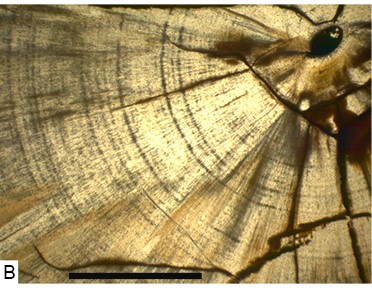 Spinosaur teeth used in the study. Like all reptiles, dinosaurs constantly replaced their teeth.
Spinosaur teeth used in the study. Like all reptiles, dinosaurs constantly replaced their teeth.
A recent study published in Palaeontologia Electronica finds spinosaurid dinosaurs regrew their teeth unusually frequently, giving new insight into the dinosaurs’ dietary habits and explaining some puzzling phenomena in the fossil record.
Spinosaurs, the family of dinosaurs including the famous Spinosaurus, were remarkable creatures, from their enormous size to their crocodile-like skulls to the iconic sail on their backs. Like all reptiles, these dinosaurs had constant tooth replacement. This means that like humans, dinosaurs lost their teeth and they got replaced with new ones. However, instead of losing only one set of “baby teeth,” the dinosaurs continued losing and replacing teeth constantly throughout their lives, just like sharks and many other living creatures.
Paleontologists Nicola Heckeberg and Oliver Rauhut were interested in how frequently spinosaurs replaced their teeth. This information may help explain patterns in the fossil record. “One riddle for a long time was the fact that many localities in western North Africa contain high amounts of isolated spinosaur teeth, but relatively few skeletal specimens,” says Dr. Rauhut. “Thus, this observation begged the question if these animals were really very abundant, and we just weren't lucky to find their skeletons, or if other aspects might have played a role.”
 A cross-sectional view of a spinosaur tooth. Notice the growth lines, which can be used to determine the tooth's age, similarly to tree rings. Scale bar = 1mm.
A cross-sectional view of a spinosaur tooth. Notice the growth lines, which can be used to determine the tooth's age, similarly to tree rings. Scale bar = 1mm.
To explore whether tooth replacement rate was one of those aspects, the researchers counted growth lines – deposits of dentine material on teeth that each represent one day of growth. “By counting these lines,” says Dr. Rauhut, “we can figure out how many days it took to form the tooth, much as growth lines in trees tell us how many years the tree lived.”
The researchers examined 5 spinosaur teeth under microscope slides using a method called thin sectioning, and counted the growth lines one by one. “It is not really easy to reliably count [growth lines] in fossil teeth,” says Dr. Rauhut. This is due to complications in the fossilization process like filling of internal cavities, replacement of minerals, and breakage. The researchers carefully counted the growth lines and repeated their counts several times with different sections of the teeth to ensure accuracy.
The oldest tooth in their sample took 271 days to form, but since a tooth starts forming long before replacing the “active” tooth, the team needed to do some calculations to estimate tooth replacement rate. Using prior data from recent reptiles and other dinosaurs, the researchers estimated tooth replacement rate to be 59-68 days for these spinosaurs. Can you imagine growing new teeth that often? This means spinosaurs replaced their teeth much faster than other theropod dinosaurs like Tyrannosaurus rex, which replaced its teeth every 777 days. “Thus, a single spinosaur obviously produced many more teeth during its life, which might at least partially explain why they are so much more abundant than other theropod teeth,” says Dr. Rauhut.
So why did spinosaurs’ teeth get replaced so often? It may have something to do with the dinosaurs’ diet. Spinosaurs are thought to have been semi-aquatic, with a preference for eating fish. These small, elusive prey required a fully functioning set of teeth to catch. Securing live, struggling prey likely put a lot of strain on the dinosaur’s teeth, increasing the risk that they might fall out or get damaged during feeding. Therefore, a fast tooth replacement rate would have been a big advantage for spinosaurs to maintain a high number of functional teeth.
This new information brings us a step closer to understanding both the peculiar abundance of spinosaur teeth and the predatory adaptations of these remarkable creatures.
To read more about this study you can find the original article here.


 Kerste Milik
Kerste Milik